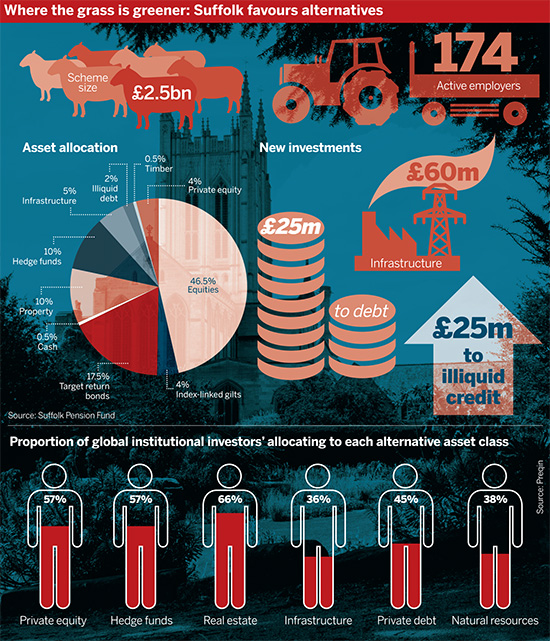The Suffolk Pension Fund has added to its alternatives allocation, including a commitment to illiquid credit and an investment in a greenfield infrastructure fund, as experts have highlighted the importance of good governance when investing in illiquids.
Over the past few years, both private and public schemes have been drawn to illiquid assets to boost diversification and returns, while consultants frequently urged investors to invest further in this space.
Investing in an illiquid fund requires member training, due diligence, and expertise to review the fund ahead of investment
Karen Shackleton, AllenbridgeEpic Investment Advisers
The £2.5bn Suffolk fund, which is part of the Access Local Government Pension Scheme pool, had approximately £114m of cash available for reinvestment, and agreed that most of this money would go towards three funds managed by incumbent manager M&G Investments.
According to the Suffolk pensions committee, this included a £60m investment in a greenfield infrastructure fund with a focus on “initial stage development construction”, later stage development construction and “expansion of long-term infrastructure”.
It also plans to allocate £25m to an illiquid credit fund and decided to put a further £25m into a pan-European debt fund.
Andrew Reid, who chairs the pension fund committee, noted that the scheme “has favoured allocations to alternative investments” in its asset allocation.

He said the infrastructure, illiquid credit and debt funds “perfectly filled the gaps in our alternatives portfolio”.
Greenfield or brownfield?
Dave Lyons, head of public sector investment consulting at Aon Hewitt, said investing in greenfield rather than brownfield projects can help a scheme achieve higher returns.
“By taking manageable development and construction risk, investors can seek to achieve higher returns compared to brownfield infrastructure investments, where these risks have likely already been played out,” he explained.
However, most pension funds are looking for brownfield infrastructure, noted James Trask, investment partner at consultancy LCP.
“It’s up and running, there’s income coming off of the assets already, and therefore there isn’t the development risk – it’s just a question of buying into the income stream.”
Opting for greenfield infrastructure means “you have higher prospected returns if you’re actually funding the development of the asset”. But because of this, there are risks involved, for example around construction and getting planning permission.
Trask said some asset managers might own mostly operating assets. “In some cases they might put a development asset into a fund but one where, for example, the construction risk is borne by the builder – the investors aren’t taking that risk, so it’s a sort of halfway house,” said Trask.
Good governance
The scheme is also putting money towards illiquid credit; Karen Shackleton, independent investment adviser at Allenbridge, said that what is driving investor interest in this space is the premium that can be accessed.
She pointed out, however, that investing in an illiquid fund requires member training, due diligence and the expertise to review the fund ahead of investment.
Once invested, “pension committees will almost certainly need to maintain a higher level of ongoing governance than a traditional credit portfolio”, but “not all schemes may be willing or able to do this”.
Illiquidity premiums move up agenda, but questions over cash flow remain
The new market liquidity regime will make it harder for pension schemes to access credit, a 2016 report said, which recommends they take steps – in particular, to exploit illiquidity premiums – to protect themselves.
Ultimately, “it is down to each scheme to decide whether they have the resources and capability to properly assess and monitor such investments”, and “of course, for the LGPS, this is one benefit of pooling”, she said.
Lyons agreed larger schemes “may have greater resources and be more confident in their ability to meet the governance requirements of undertaking these types of investments”.
However, he said it may be more challenging for a bigger fund to identify enough opportunities and reach its target asset allocation because of the need for diversification and the capacity constraints that often apply with illiquid assets.














